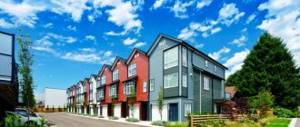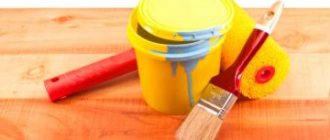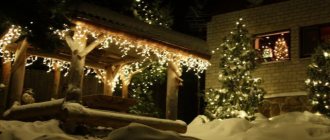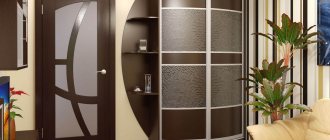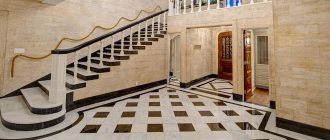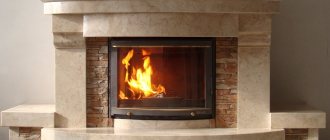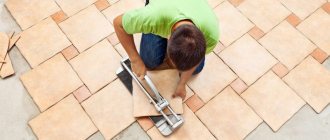In the modern market of finishing materials for facades, one of the first places in popularity is occupied by clinker bricks. Moreover, the secret of the success of this material lies not only in its affordable cost, but also in its physical and chemical properties, performance characteristics, decorative properties, and a truly enormous service life - from 100 years or more. Clinker brick can be used both as interior and exterior decoration, but most often it is used for cladding facades. Moreover, the scope of its use is not limited to certain stylistic directions of design.
What is clinker brick
In fact, the expression “clinker brick” is not entirely correct. “Clinker” literally translates from German as “brick,” that is, the expression sounds like “brick brick.” But it is already so firmly established that even manufacturers label the material this way.
If we rely on historical facts, then material of this kind first appeared more than 5 thousand years ago, in Ancient Mesopotamia. It was then that they began to produce building material from clay by firing at high temperatures - from 1,300⁰С and above. With this treatment, almost all the moisture evaporates from the clay structure, the distance between the molecules is reduced to a minimum, that is, the structure itself changes, and the material becomes very durable.
Modern production of clinker bricks has been improved and takes much less time, making the material inexpensive and accessible to consumers from all social categories. But it has not lost its basic properties, and has even become much stronger, safer in environmental terms, and its color range is represented by a huge number of shades. And the buyer faces only one question - how to choose clinker bricks for cladding the facade of the house.
Stages of facing the facade with brick
The technology for cladding the facade of a house with bricks involves the following stages of work:
- Calculation in advance of the required number of bricks plus a reserve of 10% for damage during the laying process.
- Test masonry of 1 m2 to check the properties of the mortar and determine the method of filling the joints.
- Laying “dry” without mortar and disassembling a trial row to calculate the actual brick consumption and determine the required thickness of the joints.
- The masonry is carried out in one way from beginning to end, using the same method of preparing the mortar, regardless of whether the base or wall surfaces are covered.
- When preparing the solution, strictly follow the manufacturer's instructions (instructions).
- To obtain a uniform color of the masonry, bricks from different pallets are used simultaneously.
- To remove dust from the surface of the brick, it is briefly immersed in water before laying, because dry brick instantly absorbs water from the mortar, which makes the masonry less durable.
- During the masonry process, both the horizontality of the masonry rows and the verticality of the mortar joints are periodically checked using levels and plumbs.
- When the mortar thickens slightly, in order to compact the seams and give them a more aesthetic appearance, the mortar in the masonry joints is carefully smoothed with a trowel with a special form.
- The facing is cleaned of solution residues by treating with a 10% perchloric acid solution.
- Plastering the seams (if desired) is carried out to give the masonry greater aesthetics. The seams are carefully scraped out to 1.5 - 2 cm, and the resulting cracks are filled with a thick solution.
Brick cladding is an expensive, but also the most reliable way to finish a facade. Laying facing bricks requires certain skills, so entrust it to a professional, and the beauty of the facade of your house will delight you! We recommend that you find out what hydrophobization is.
Technical characteristics of clinker bricks
For the production of clinker bricks, special, refractory clay is used. Color is very rarely given to a material using foreign pigments, and depends on the location of extraction of the original substance, its chemical composition and the presence of certain microelements in the structure of the clay. Before becoming a clinker brick, clay goes through three stages of processing - purification from foreign impurities and air, molding and evaporation of moisture, long-term firing at temperatures of 1,600⁰C and above.
The market for construction and finishing materials offers several types of clinker bricks:
- facing,
- shaped,
- road,
- refractory.
Almost all of them can be used for cladding facades, with the exception of road bricks - they are quite thick and heavy, and are more expensive than other types of clinker bricks.
The technical characteristics of clinker are as close as possible to the properties of natural stone - minimal water absorption, high density and strength, frost resistance, low thermal conductivity, resistance to alkalis, salts and acids. The color palette of this material is presented in tones from black to pale yellow, that is, you can choose a shade to your liking and for an individual design project or landscape.
Classification of facing bricks
The gradation of façade cladding is determined by its manufacturing technology.
There are four categories of facing bricks:
- Ceramic.
- Clinker.
- Hyper-pressed (concrete).
- Silicate.
Brick in each of the listed categories is available in two versions: solid and hollow. The weight of hollow core brick is on average 25-35% less, and its resistance to heat loss is approximately 10-15% higher.
Ceramic facing brick
It is produced by firing a raw material mixture consisting of red fusible clay, organic and mineral additives that regulate plasticity. Coal dust, slag, fireclay, sawdust, ash and quartz sand are used in this capacity. The initial mixture successively goes through the processes of molding, drying and firing. The main difference between facing ceramic bricks and ordinary ones is the careful preparation of the components before molding. Therefore, there are no foreign inclusions or cracks in it.
The material obtained at the exit from the firing chamber is resistant to moisture, high strength and good energy-saving qualities. The types and colors of ceramic facing bricks are varied.
On sale you can find not only ordinary, but also shaped material (for laying complex architectural elements). To expand the color range, manufacturers use mineral dyes (chromium oxide, finely ground iron or manganese ore), adding them to the composition of the feedstock.
Decorating the surface of ceramic bricks is done in several ways. In addition to the smooth matte and shiny surface, finishing options are available that give this material a resemblance to wild stone.
Clinker brick
The closest “relative” of ceramic brick. The main difference between them is the raw materials and firing temperature. Medium and refractory clays are used to produce clinker. Accordingly, they are fired at a higher temperature. The result is a very dense and durable facing brick with minimal water absorption. These qualities make it possible to use it not only in facade decoration, but also for cladding the base of the foundation, building fences and paving paths.
The thermal conductivity of clinker stone is higher than that of ceramic stone. This disadvantage is compensated by its high resistance to cracking under the influence of low temperatures.
The color palette and texture of clinker stone are extremely diverse, since each manufacturer offers customers its own collections. The size range of this cladding also cannot be called boring. In addition to the standard single version 250x120x65 mm, you can buy bricks of reduced thickness and height, as well as long clinker (528x108x37 mm).
Hyperpressed brick
Firing clay is an energy-intensive process and not very profitable. Therefore, many manufacturers are switching to pressed unfired bricks. Its basis is granite screenings, water and cement. At its core, it is super-dense concrete, which has been shaped into masonry bricks.
The main requirement for façade finishing is resistance to weathering. According to this indicator, hyper-pressed brick is perfect for finishing external walls.
In terms of strength and other quality characteristics, it is practically not inferior to clinker. Thanks to the texture of the surface (rock, torn stone) and the use of persistent dyes, this material looks excellent in masonry.
Finishing the facade with hyper-pressed brick looks elegant, solid and reliable
Sand-lime brick
Belongs to the category of non-firing materials. It differs from hyperpressed brick in its raw material composition. There is no cement in it. High mechanical strength is achieved here by hardening a mixture of silicate sand and slaked lime in an autoclave (high temperature and pressure).
Nowadays, silicate facade brick as a facing material is losing its former popularity. In the struggle for buyers, manufacturers have developed several color options for the silicate mixture. Unfortunately, they all look rather pale and cannot compete with the rich colors of ceramics and clinker.
This material behaves well in building cladding. Compared to clinker bricks, they absorb moisture more strongly, but at the same time, they can withstand repeated soaking, freezing and thawing better than ceramics.
Figured (shaped) brick
Today, no one is satisfied with the straight lines of the facade, so each type of facing brick is complemented by a wide range of shaped elements. Using them, you can lay out complex architectural elements without laborious hewing and cutting, dressing your house in a beautiful “stone lace”.
Types of clinker bricks for facades and their properties
For finishing facades, experts recommend using clinker bricks with voids in the structure - it is lighter and does not create a serious load on the walls and facade of the building. In addition, the air layer of the cladding increases the heat resistance of the house. The front side of hollow clinker bricks for facade finishing can be:
- glazed,
- matte,
- glossy,
- corrugated.
The best option, taking into account the climatic conditions of Russia, is glazed clinker brick. A facade with such a coating will reliably protect the walls of the building from moisture, increase their thermal insulation characteristics, and will look respectable and luxurious.
Corrugated clinker brick creates a structured surface. If this particular type is chosen for finishing the facade, then you need to work out the design project in detail - using a material with this texture you can create geometric patterns, ornaments, and inscriptions on the walls of the house. But matte and glossy variations in the surface of clinker bricks affect not only the design style of the building, but also the surrounding area as a whole. It is important to understand that a glossy surface will reflect strongly on a clear day, which can be uncomfortable.
Advantages of clinker bricks
Like any other finishing material for facade cladding, clinker brick has its pros and cons. But there are still more advantages:
- a huge range of shades and textures (more than 200 types), allowing you to bring to life the most daring design ideas in the decoration of facades,
- clinker brick cladding, if its installation technology is followed, will last at least 100 years,
- the structure and properties of the material do not change under the influence of high or extremely low temperatures,
- clinker brick does not absorb moisture and does not allow steam to pass through, which makes its thermal insulation properties unique,
- the coating made of this material is easy to care for, it is resistant to mechanical and chemical damage (for example, acid rain),
- The clinker does not contain chemical compounds, which makes it absolutely safe for households and the environment,
- This material can be used to form not only wall cladding, but also arches, vaults, cornices and decorative columns.
The only disadvantage of clinker brick as a finishing material for facades is that for its installation it is necessary to use a special composition - a solution of sand with a fraction of at least 2 mm and Portland cement (a mixture of cement, gypsum and calcium silicate).
Shaped brick figured
Shaped (curly) brick is a type of facing stone with an angular, semicircular or U-shaped shape. This brick is used to decorate window openings, cornices, decorative walls, parapets, lay out various ornaments, its use allows you to realize the most daring architectural designs.
Corner Cornice edge Arch Bay corners Columns and semi-columns
Corner junction Window sill Basement edge Steps and tiles Corner junction
Not every brick can be used to decorate the facade of a building.
Fireclay (fire-resistant) brick can withstand high temperatures well, but does not tolerate moisture and freezing well - facing masonry made from it is unacceptable. Acid-resistant ceramics made from rare types of clay have excellent strength and performance characteristics, but their cost is 20%–30% higher than clinker bricks of similar sizes.
Chelsea clinker brick, Röben company
What is the optimal price/quality ratio for finishing facades?
Good fired bricks are ceramic and clinker: they have suitable characteristics in terms of strength, frost resistance and thermal conductivity, are quite affordable and provide scope for decorative facing masonry.
Unfired bricks (silicate, hyper-pressed, concrete) are good for textured masonry (for example, wild stone), they are often available in a wide color palette, but require additional costs for protecting and maintaining the finished surface.
Sand-lime brick is easily distinguished by its whitish cement tint
Clinker brick
Clinker brick, a ceramic building material made from clay by firing raw materials until completely sintered, is extremely strong and durable, and has very high wear resistance. It has virtually no restrictions on texture and colors, can imitate an antique surface, and retain the firing effect, which makes it extremely aesthetic and in demand in a variety of areas of construction.
In everyday life, the word “clinker” also refers to high-strength brick tiles and paving slabs.
Hyper-pressed brick
Made from a special mixture of limestone, cement and special dyes; is a bar that is correct in shape and ideal in color, which is used for finishing and facing work. Particularly popular is brick with a heterogeneous structure, which makes it possible to stylize the cladding of facades to resemble “ragged” stone.
How to choose clinker brick
The criteria for choosing clinker are identical to the criteria for choosing ordinary brick, ceramics or decorative stone. It is important to take into account technical, functional characteristics, and aesthetic data, understand that a large batch will be purchased, and try to track its quality.
The choice of clinker bricks can only begin after a design project for the cladding of the house has been created and all its details have been thought through - the color of the facade, the method of finishing windows and doorways, the use of contrasting tones or the exclusion of such stylistic solutions. Already for the design project, the type of clinker brick and its front side is selected.
The density, structure and thickness of the clinker must correspond to the characteristics of the structure - the level of its wear, the subtleties of operation (country house or residential building), and the climatic data of the region where it is located.
Country of origin and brand matter, but your choice should be based on technical data. For example, clinker bricks with density indicators of 2,000, moisture absorption - at least 3, frost resistance - F200, vapor permeability - 0.07, acid resistance - 95, thermal conductivity - 1.17 - are suitable for cladding buildings. If the quality certificate of the material contains exactly such data, then you can safely buy it for finishing the facade.
Production of clinker bricks
For the production of this building material the following is used:
- Fireclay (fireclay). It is also called refractory or “skinny” clay;
- Powdered igneous rocks (they increase the volume of glass phase in the product);
- Feldspars;
- Clay minerals (silicates that make up the core mass of clay deposits). It is they who give the brick all the known physical, chemical and mechanical properties.
The process of making clinker bricks is as follows:
1. Initially, mix the components into a homogeneous clay mass.
2. The finished mixture is diluted with water and then pressed through an extruder. At this stage, the material in question takes shape.
3. The resulting brick blank is sent for drying, as a result of which the moisture content in the material is reduced to 3% (and in the case of high-quality clinker - to 2%).
4. The resulting product is sent to a tunnel kiln, where it is fired at a temperature of 1200-1300°C. And this is the key difference between clinker and ordinary brick, which is fired at a temperature of 800-1000°C.
Clinker brick facade design options
Nowadays it is extremely popular to change the “appearance” of a house using facade cladding. Clinker brick opens up practically limitless possibilities in shaping the style of exterior decoration. The most popular directions are:
- modern classic,
- village ethno,
- Scandinavian style,
- European,
- country.
Modern classics in facades are close to the English style with a touch of Greek - with arches and columns, structured but discreet planes, large windows and wooden doors. The color scheme is as democratic as possible - shades characteristic of brick, without painting.
Country, Scandinavian style and rustic ethno suggest the presence of wood against a brick background - finishing windows and doors, painting in light shades or using light yellow clinker is possible. The main requirement is naturalness, the presence of natural tones and structured or artificially aged surfaces. Ideally smooth materials are not suitable for these styles.
The European style is very popular when finishing facades with clinker bricks - with brick planes enclosed in frames of a contrasting color made of a similar material or wood.
Features of façade finishing with clinker bricks
Laying clinker bricks can only be done using a special mortar - hard, with high strength values. It is better to entrust this work to professionals, since skills in laying such material and knowledge of the technology for creating the solution are required. Ready-made mixtures may not meet the technical characteristics of the clinker or the surface that will be lined with it.
It is possible to cladding a façade with clinker bricks with your own hands in a high-quality manner only under the guidance of a master or after a detailed study of all the nuances and features of the technology. It is very important to lay out the first tier correctly - dry, taking into account further accurate marking of the inter-tile joints.
The process of laying clinker is identical to the process of laying ordinary bricks, but the time interval between laying the next tier is much longer, since the special solution for clinker material takes longer to dry and shrink. Only a professional can determine its duration in each specific case. To fix the cladding, it is recommended to use stainless steel anchors. Decorative work - removing the outer layer of mortar from the joints - is carried out no earlier than 5 days after the completion of the façade cladding work.

